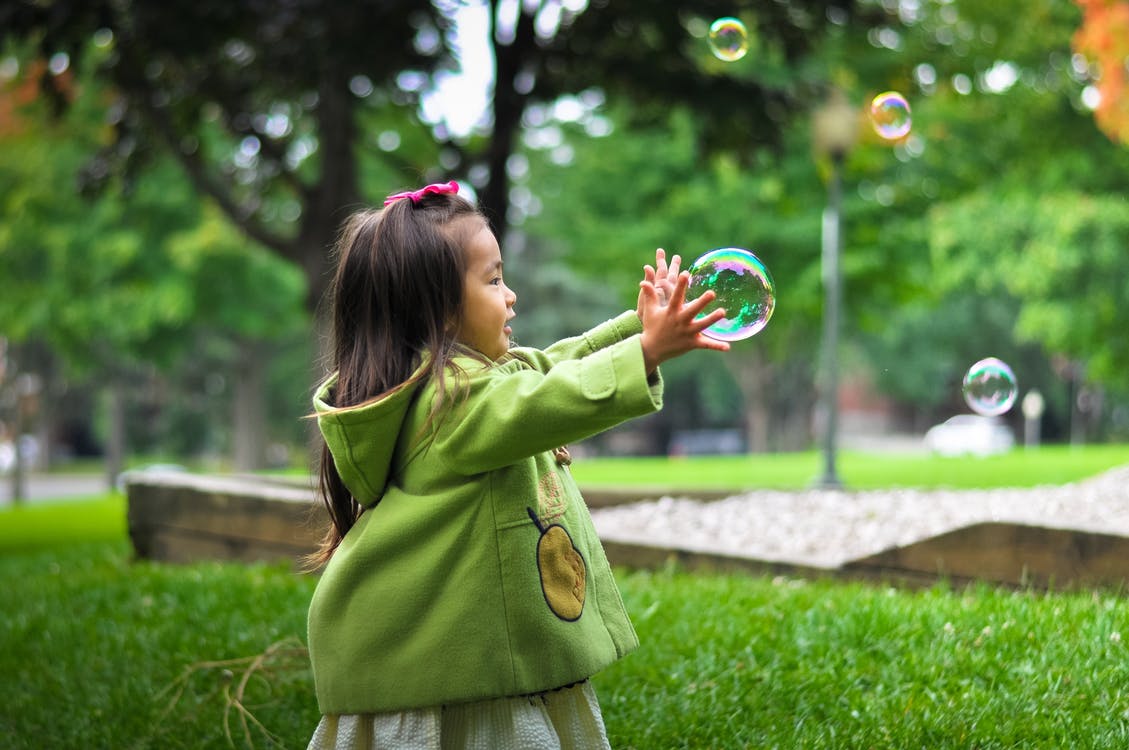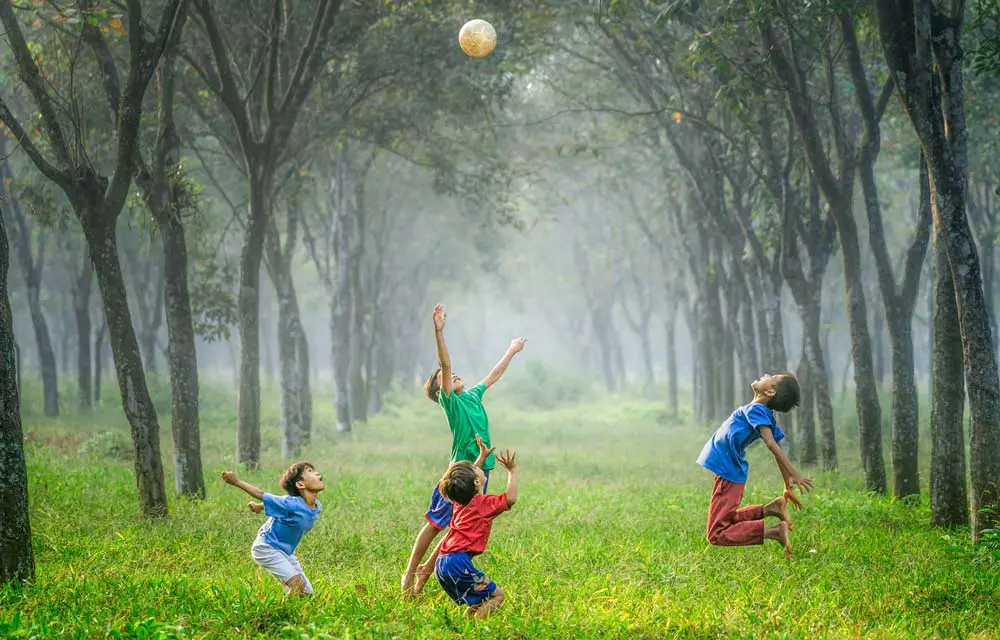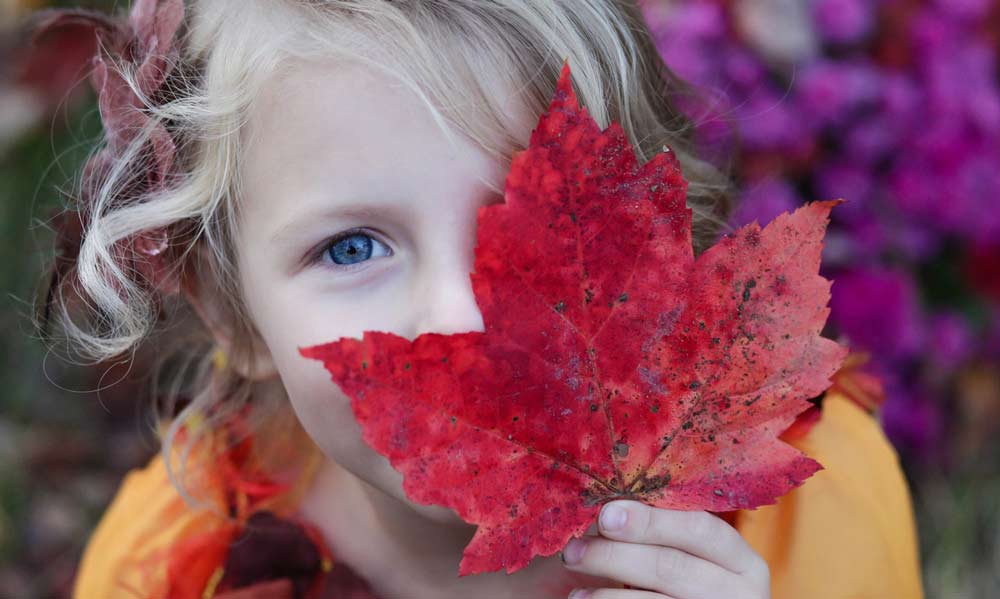![How To Deal With Sensory Overload [9 Tips For Overstimulation]](https://happyrubin.com/wp-content/uploads/2019/12/ik-ben-overprikkeld-150x150.jpg)
11 Mindfulness Exercises For Kids (The # 1 Most Important One!)

What are the most important mindfulness practices for children? We’ll stick to the essentials in this article (plus 11 important exercises) so you know what that one thing is that you should give your kids when it comes down to mindfulness…
Contents of this page:
We don’t have to teach our kids anything about mindfulness!
It makes sense that we don’t have to teach children anything when it comes to mindfulness. It is rather the other way around: we can learn something from children.
We therefore do not want to focus too much on the well-known mindfulness exercises for children, such as the famous frog exercise by Eline Snel or the weather forecast. We stick to the essentials: one essential thing you should give your kids …
While your child is growing up, they learn all kinds of new things about the world. This can be done in two ways. One of those ways is the mindful way and brings the child fully into life. The other way separates the child further and further from life …
# 1 Most important mindfulness practice for kids: Let the child discover the world

Suppose you are walking with the child in the park. The child naturally wants to learn and discover everything . The trick is to facilitate that, and not to interrupt it with ‘labels’ (language & judgments are limiting).
Does the child walk to a branch and pick it up? Have the child watch after learning the word ‘tak’. If you just say, “That’s a branch,” and you walk on, the child will stop discovering because it has found a concept.
Does the child ask for a piece of paper? Put the leaf in his hand and ask questions about all things that can be perceived. Encourage him to discover the leaf, instead of just labeling with words and concepts.
There is an illusion: that if you have attached a word to it, then you know what it is. But you only attached a word to it. You don’t know what it is yet! Then all the child has is a lot of labels. You can of course give excellent labels, but there is much more. When you’re just going to label things with a kid, you’re basically saying, “I’ll give you the discovered world.”
Exercises 2-11: Other good mindfulness techniques for kids

If you would like some more concrete tools for mindfulness exercises for children, here are a number of bullets about what you can get your child to do and say.
- Let the child express his / her feelings : what does the child feel inside? What emotions does the child feel?
- Let the child also give words to his / her inner experiences . What emotion did the child feel? What color is the emotion? What kind of weather is it inside you? Is it storming, is the sun shining, is it overcast and / or is it raining? We will of course leave that weather exactly as it is, because we cannot change the weather outside. Emotions, feelings and moods come and go all by themselves!
- Help the child not to judge it when the child is experiencing and / or expressing an emotion. The emotion may be expressed but the emotion is neither good nor bad.
- Support the child to be able to create the choice not to have to react directly from an emotion. The child can allow what they experience, but the child does not necessarily have to give in to the automatic response. Mindfulness gives the child options so that they can choose how they want to act.
- Monotasking : Encourage the child to pay active attention to all of his / her activities. If the child is engaged in a social activity, encourage the child to really pay attention to the other.
- Put on some sad music and then put on some happy music: discover together with the child what the music does to you.
- Children love the exercises for sensory acuity . For example, listen in silence together to all the sounds you hear in the environment. It is wonderful to just listen.
- Use the exercise for sensory acumen in everyday life as well. For example, when you are walking to hockey practice with the child or when you are waiting somewhere. Guide your child not to be preoccupied with what’s going to happen next. Encourage your child to stay in this moment, which can easily be done by opening the senses again.
- Do a ‘regular’ meditation or mindfulness exercise with the child.
- Wrap a mindfulness meditation in a ‘pretend frame’. Eline Snel came up with the frog meditation for this , in which the child pretends to be a watchful frog.
How do you apply mindfulness with children? What is your favorite exercise? Let me know in the comments.

![5 Best Self Care Tips For College Students [#1 Advice]](https://happyrubin.com/wp-content/uploads/2021/09/the-best-self-care-tips-for-college-students-440x264.jpg)
![How To Stick To New Year’s Resolutions: 9 Tips [Smart & Sure Ways]](https://happyrubin.com/wp-content/uploads/2019/12/tips-voor-goede-voornemens-440x264.jpg)
![How To Stop Being So Hard On Yourself [9 Great Tips]](https://happyrubin.com/wp-content/uploads/2019/12/we-moeten-zoveel-van-onszelf-en-anderen-150x150.jpg)

![19 Best Ice Breaker & Get-To-Know-Eachother Games [Fun & Simple]](https://happyrubin.com/wp-content/uploads/2018/02/leukste-ijsbrekers.jpeg)
![Becoming More Social: 41 Tips [Improving Social Skills] [List]](https://happyrubin.com/wp-content/uploads/2018/06/sociale-vaardigheden1.jpeg)
![How to start a conversation with anyone: 15 tips [Making contact]](https://happyrubin.com/wp-content/uploads/2017/08/gesprekstechnieken1.jpeg)
![372 Friend Tag Q&A Questions [Best Friend Quiz]](https://happyrubin.com/wp-content/uploads/2019/05/best-friend-tag-vragen-voorbeelden.jpg)



![Clingy & controlling behavior of partner/date [Extreme examples]](https://happyrubin.com/wp-content/uploads/2020/06/claimerig-gedrag-van-partner-eigenschappen-en-voorbeelden-150x150.jpg)

![How to recognize if a man is in love [Signals & his body language]](https://happyrubin.com/wp-content/uploads/2020/05/verliefd-gedrag-van-mannen-herkennen-150x150.jpg)


![Free will and religion / theology [Verses & Quotes on free will]](https://happyrubin.com/wp-content/uploads/2020/10/religion-on-free-will-quotes-1050x640-1-150x150.jpg)

![Dealing With Setbacks & Hardship [Lessons & Examples]](https://happyrubin.com/wp-content/uploads/2018/11/omgaan-met-tegenslag-tips-hoe-dan.jpeg)
![NLP Agreement Frame: Use these exact sentences [Examples]](https://happyrubin.com/wp-content/uploads/2020/10/agreement-frame-nlp-1125x640-1-440x264.jpeg)
![122 Best Comebacks In Any Situation [Best Examples]](https://happyrubin.com/wp-content/uploads/2020/06/beste-comebacks-technieken-tips-440x264.jpg)
![Using Hypnosis to Stop Smoking [HowTo]](https://happyrubin.com/wp-content/uploads/2020/05/stoppen-met-roken-door-hypnose-150x150.jpg)
![Presuppositions language pattern: meaning & examples [NLP]](https://happyrubin.com/wp-content/uploads/2020/04/wat-zijn-vooronderstellingen-150x150.jpg)
![Peripheral Vision: Meaning & Exercise [Essential Skill]](https://happyrubin.com/wp-content/uploads/2020/04/perifeer-zicht-trainen-tips-150x150.jpg)

![How To Start A Coaching Business [21 Smart Tips]](https://happyrubin.com/wp-content/uploads/2018/11/coachingpraktijk-starten-tips.jpeg)
![How to make dreams come true? [33 tips to realize dreams 100%]](https://happyrubin.com/wp-content/uploads/2018/05/dromen-mijlpalen.jpeg)
![How To Become Rich? 27 Millionaire Tips [Guaranteed To Work]](https://happyrubin.com/wp-content/uploads/2018/01/hoe-kan-ik-rijk-worden.jpeg)
![77 Best Online Marketing Tools [Recommendations] [Also Free]](https://happyrubin.com/wp-content/uploads/2018/08/beste-onlne-marketing-tools-tips.jpeg)
![Complete List Of Virtues & Qualities [Including Explanation]](https://happyrubin.com/wp-content/uploads/2018/12/kernkwaliteiten-uitleg.jpeg)
![Being Attentive: How Do You Do That? [Meaning & 9 Tips]](https://happyrubin.com/wp-content/uploads/2019/05/attent-zijn.jpg)
![Being Conscientious: Meaning Of This Virtue [Explained]](https://happyrubin.com/wp-content/uploads/2018/07/Consciëntieus-persoon.jpg)


![Best Books About Burn-Out [Top 10] [Update 2025]](https://happyrubin.com/wp-content/uploads/2020/06/beste-boeken-over-burnout-lijst-440x264.jpg)
![Best Self-love Books [Top 10] [Update 2025]](https://happyrubin.com/wp-content/uploads/2020/04/beste-boeken-over-zelfliefde-aanraders-440x264.jpg)
![Life changing books: 10 books that change your life [2025 Update]](https://happyrubin.com/wp-content/uploads/2020/03/levensveranderende-boeken-tips-150x150.jpg)
![Top 10 Best Books: Recommendations Per Genre [2025 Update]](https://happyrubin.com/wp-content/uploads/2019/12/best-books-per-genre-150x150.png)
![Best Books On procrastination: Must Reads [List] [2025 Update]](https://happyrubin.com/wp-content/uploads/2019/11/beste-boeken-over-uitstelgedrag-tips-150x150.jpg)
![Joe Dispenza: Events To Attend [2025 & 2026] [All Info]](https://happyrubin.com/wp-content/uploads/2020/02/joe-dispenxa-events-440x264.png)
![Best Online Study Options [Online Education Top List]](https://happyrubin.com/wp-content/uploads/2019/03/best-home-study-options-440x264.png)
![Teachable Review & Experiences 2025 [Bad Online Training Tool?]](https://happyrubin.com/wp-content/uploads/2020/02/Teachable-review-ervaringen-150x150.png)
![Audible Review, Experiences & Special Discount [Scam?]](https://happyrubin.com/wp-content/uploads/2020/01/audible-review-ervaringen-150x150.png)
![Guest Posts Wanted [Free & Always Directly Accepted]](https://happyrubin.com/wp-content/uploads/2019/05/gastbloggen-regels.jpg)
